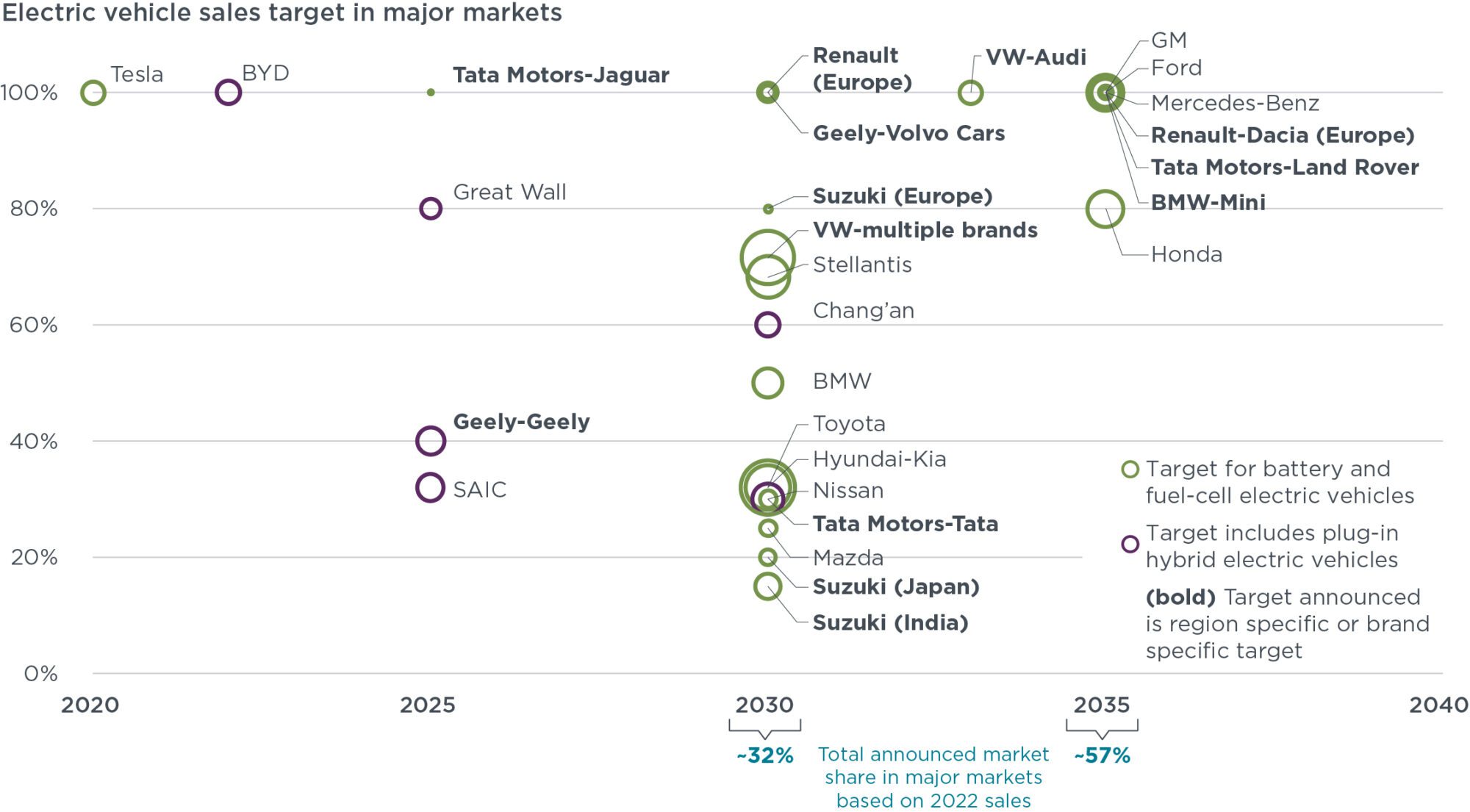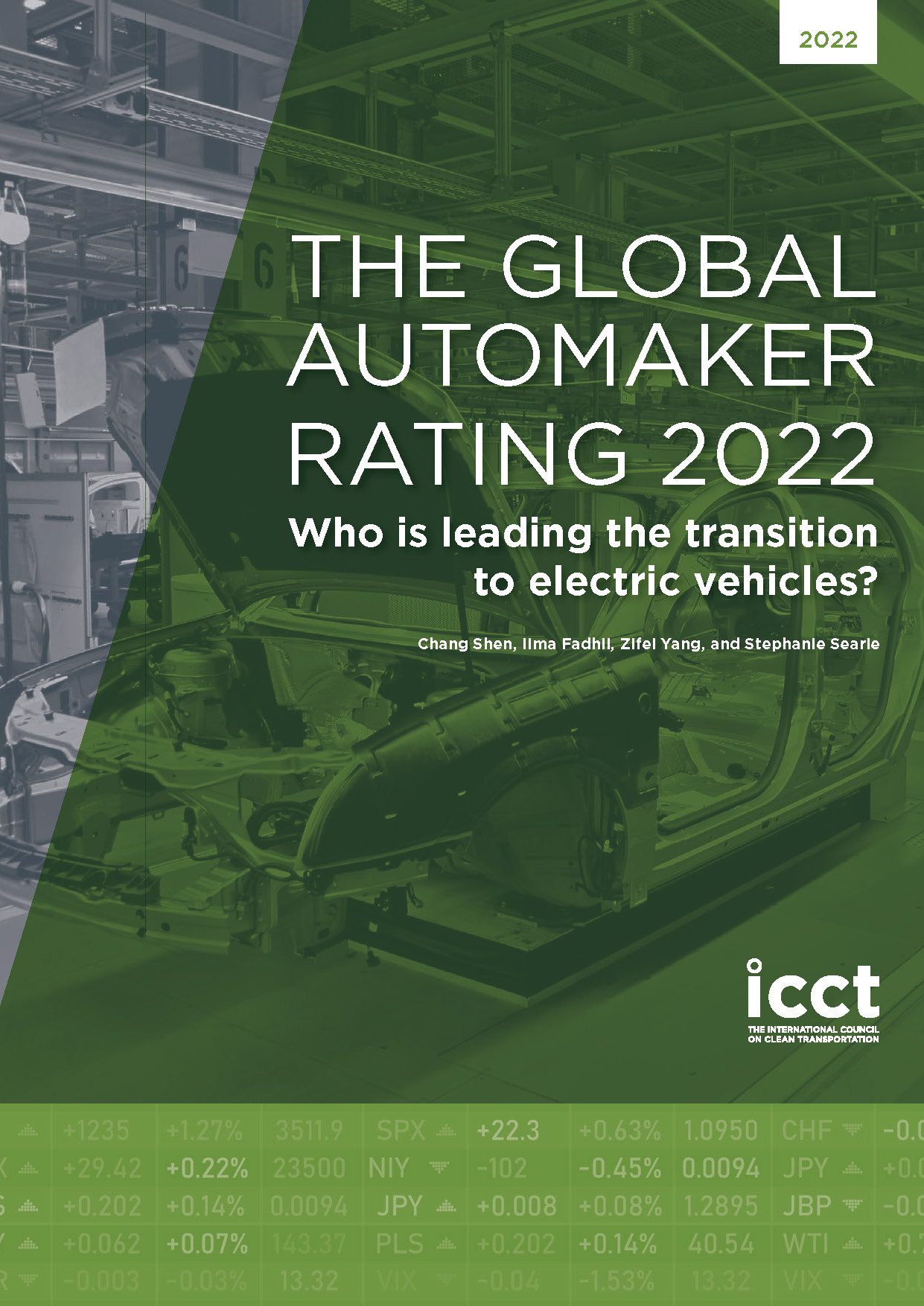New Global Automaker Rating identifies leaders and laggards in the transition to electric vehicles
Blog
Which automakers are keeping the ZEV momentum strong?
Amidst the rapid development of ZEV technologies, automakers are busy updating their product lines to match the evolving market. Earlier this year, VW Group increased its ZEV target for the VW brand in Europe from 70% to 80% of new sales by 2030 for passenger cars. Suzuki announced in January that it will introduce its first battery electric vehicle (BEV) in Japan in 2023 and its first in Europe and India in 2024. By 2030, the manufacturer aims to reach 20% BEV sales in Japan, 80% in Europe, and 15% in India.
Overall, the 20 automakers assessed continue to show variations in their level of ambition toward a full ZEV transition. The figure below maps announced ZEV targets at the global and regional level as of September 2023. ZEV-only targets (i.e., only BEVs and fuel cell electric vehicles count) are depicted as green circles and electric vehicle (EV) targets, which also include plug-in hybrid electric vehicles (PHEVs), are depicted as purple circles. The size of the bubble represents the vehicle sales volume of each automaker. Bolded manufacturers represent targets that are region specific and/or brand specific.

Most manufacturers with multiple brands show a varying level of ZEV targets and market coverage. Two other big players, VW and Stellantis, are committed to multiple ZEV targets across different brands and regions. VW’s targets for its Audi and ŠKODA brands have not changed since the 2022 target summary, with an overall target level of 70%. All the targets combined account for 72% and 68%, respectively, of their global LDV sales in 2022. Both automakers set a more ambitious target in Europe than elsewhere and focus on passenger cars, rather than on the broader LDV segment. Additionally, both automakers pledged a 50% ZEV target for LDVs by 2030 in the United States, their second and third largest market, respectively.
While India-headquartered Tata Motors has a worldwide target of at least 30% ZEV sales by 2030, the Jaguar and Land Rover brands aim to achieve 100% ZEVs in the leading markets by 2025 and 2035, respectively. This is not the case for all, though. Hyundai aims to have ZEVs be 36% of its global sales (including Genesis) by 2030 and Kia aims to have ZEVs be 30% of its global sales by 2030.
Over the past year, manufacturers headquartered in Japan have made more commitments, but still lag manufacturers headquartered in other major markets. Nissan and Honda announced global ZEV targets of 50% by 2030 and 80% by 2035, respectively, and both are more ambitious than Toyota’s target of approximately 32% ZEVs by 2030 and Mazda’s goal of 25% ZEVs by 2030.
If manufacturers meet the goals described above, that works out to approximately 32% EVs by 2030 and 57% EVs by 2035 in the leading markets. This number is still behind the 100% ZEVs by 2035 target needed to stay on track with the Paris Agreement climate goals.
Targets and goals are important, but it’s the follow-through that matters most for achieving meaningful decarbonization. Indeed, the increased ambition in announced ZEV targets among automakers is happening in parallel with regulations proposed and adopted by governments across the globe that establish more stringent CO2 standards or require higher ZEV penetration. In March 2023, the European Union adopted CO2 emission standards that require a 100% ZEV sales share by 2035 for passenger cars and light commercial vehicles. Aligned with this, we see that several automakers have set more ambitious EV targets in Europe than in other regions.
Further, in April 2023, the U.S. Environmental Protection Agency (EPA) released its Multi-Pollutant Emissions Standards proposal for 2027 and beyond, and it estimates that 60% ZEVs by 2030 and 67% ZEVs by 2032 for LDVs are needed to meet the standards. This ZEV market share is higher than the ZEV target for the United States set by the majority of the automakers.
While these manufacturer announcements are non-binding, regulations adopted in more vehicle markets, together with manufacturer goals, would set a clear path to accelerate the pace toward a 100% global ZEV fleet.
Author
Related Publications
Evaluates how the world’s top 20 light-duty vehicle manufacturers stack up in the transition to electric vehicles by rating them on 10 custom-built metrics that reflect their actions and plans.


